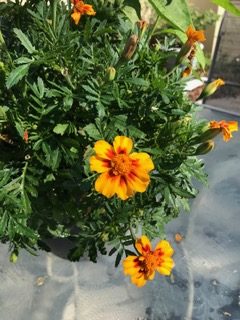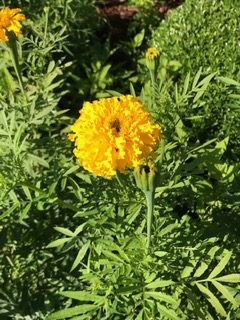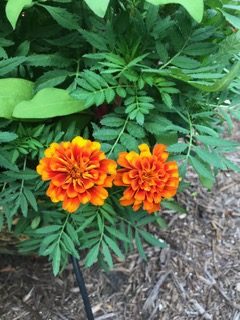Tagetes erecta, or we commonly know them as marigolds, is an herbaceous annual. Marigolds are native to Mexico, even the French cultivar. Marigolds can be compact and bushy or tall and leafy. They prefer full sun in well-drained, dry to moist soil. They will bloom all season long if deadheaded. They are drought tolerant once established. Depending on the gardener, the flowers have a pleasing or not so pleasing scent. Marigolds can be used to deter insects and small mammals in the garden.
Marigolds are easy to grow. They can be started from seed indoors, sewn directly into the garden after the last frost, or bought in the local garden center.
Marigolds are great for flower beds or containers. They attract pollinators, bees, ladybugs, parasitic wasps, hoverflies, and other beneficial insects that protect your plants from aphids and other harmful pests.
If marigolds are planted with vegetables, chop up the plants and work into the soil once they are killed by frost to help deter nematodes. The roots and stems emit a chemical that may suppress the population of root-knot nematodes, tiny soil borne worms that feed on the roots of ornamental plants and vegetables. www.gardeningknowhow.com
Marigolds may protect cruciferous plants (cauliflower, broccoli, kale, etc) from cabbageworms and tomato plants from hornworms. Marigolds are a good companion plant for bush beans, squash, cucumbers, and eggplant. www.gardeningknowhow.com
Calendula officinalis, commonly called English marigold or pot marigold, is a different plant from the common marigold. They are both members of the Asteraceae family which also includes daisies and chrysanthemums. When adding to the garden be sure to read the package thoroughly so you don’t mistake the two.
Planting marigolds can’t be much easier. Be sure to pick up some seed packets or plants to add to your garden next spring.
Photos and information by Jeanne Pavero
North Carolina Extension Gardener Plant Toolbox



